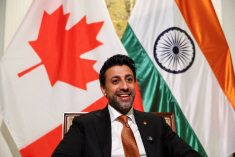U.S. President Donald Trump said on Monday automobile tariffs are coming soon even as he indicated that not all of his threatened levies would be imposed on April 2 and some countries may get breaks, a move Wall Street took as a sign of flexibility on a matter that has roiled markets for weeks.
Why it matters: Already battered by tariffs and tariff threats, further trade disruptions threaten serious harm to Canadian farmers.
At the same time, Trump opened another front in a global trade war by slapping 25 per cent secondary tariffs on any country that buys oil or gas from Venezuela, a directive that sent oil prices climbing.
Read Also

U.S. senators push USDA for urgent action on bird flu vaccine
A bipartisan group of U.S. senators this week urged the administration of President Donald Trump to finalize a science-based plan for developing a bird flu vaccine for livestock, according to a letter seen by Reuters.
According to Canada Energy Regulator data, Canada does not import oil from Venezuela, though most recent statistics date to 2023.
Not all tariffs coming on April 2
At the White House, Trump told reporters not all the new tariffs would be announced on April 2, and said he may give “a lot of countries” breaks on tariffs. He provided no details.
A White House official declined to say exactly when sector-specific tariffs on autos, pharmaceuticals or semiconductor chips would come into effect, noting that was still “TBD (to be determined) and at the president’s discretion.”
The official cautioned against expecting a tariff reprieve, adding, “The president is determined to implement reciprocal tariffs that are very strong. People should expect that.”
Bloomberg and the Wall Street Journal reported earlier that the administration was narrowing its approach to the broad batch of levies Trump has been saying for weeks would be imposed on April 2 and could delay sector-specific tariffs.
U.S. stocks ended Monday broadly higher on optimism that the tariffs set to be detailed next week may not be as extensive as expected. The S&P 500 index gained nearly 1.8 per cent to close at its highest in more than two weeks.
Meanwhile, Trump said the U.S. would impose tariffs on autos, pharmaceuticals and aluminum in “the very near future,” arguing that the U.S. would need all those products in the event of wars or other problems.
“We’ve been ripped off by every country,” Trump said after a meeting of his cabinet, predicting that the expected tariffs would raise “rather astronomical” amounts of money for U.S. coffers, allowing tax rates to remain low or come down.
Which countries are in the crosshairs?
Trump said the April 2 tariffs will mark a “Liberation Day” for the U.S. economy. They are aimed at shrinking a $1.2 trillion global goods trade deficit by raising U.S. levies to levels charged by other countries and counteracting their non-tariff trade barriers. Two senior Trump officials – Treasury Secretary Scott Bessent and top White House Economic Adviser Kevin Hassett – said last week the administration is expected to focus the April 2 reciprocal tariff news on a narrower set of countries with the biggest trade surpluses and high tariff and non-tariff barriers.
In a request for public comments on reciprocal tariffs, the Office of the United States Trade Representative expressed particular interest in submissions for the largest U.S. trade partners, and those with the highest goods trade surpluses.
USTR named Argentina, Australia, Brazil, Canada, China, the European Union, India, Indonesia, Japan, Korea, Malaysia, Mexico, Russia, Saudi Arabia, South Africa, Switzerland, Taiwan, Thailand, Turkey, Britain and Vietnam as being of particular interest, adding that they cover 88 per cent of total goods trade with the U.S.
— Reporting by Andrea Shalal, Timothy Gardner, David Lawder and Steve Holland















